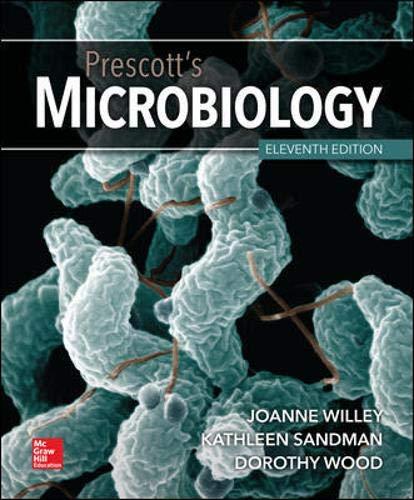
Prescott's Microbiology
11th Edition
ISBN: 9781260211887
Author: WILLEY, Sandman, Wood
Publisher: McGraw Hill
expand_more
expand_more
format_list_bulleted
Concept explainers
Question
Chapter 16.6, Problem 1MI
Summary Introduction
Conjugation is referred to as the transfer of DNA or genetic material between two organisms or cells through direct cell-to-cell contact (temporary physical contact). The mechanism of conjugation in cells is mainly depending on the presence of plasmids (conjugative plasmids). In bacteria, chromosomal genes are transferred through plasmid-mediated conjugation. Plasmids are small, DNA (double-stranded) molecules and they can exist independently in the chromosome of the host organism.
Expert Solution & Answer
Trending nowThis is a popular solution!

Students have asked these similar questions
What is epistatic?
What is sere?
In 2-3 sentences only, What is the important difference in terms of function between fat-soluble vitamins and water-soluble vitamins?
Chapter 16 Solutions
Prescott's Microbiology
Ch. 16.1 - Retrieve, Infer, Apply List three ways in which...Ch. 16.1 - Compare and contrast the means by which the...Ch. 16.1 - Give examples of intragenic and extragenic...Ch. 16.1 - Retrieve, Infer, Apply Sometimes a point mutation...Ch. 16.1 - Retrieve, Infer, Apply Why might a missense...Ch. 16.2 - How would you screen for a tryptophan auxotroph?...Ch. 16.2 - Why is a small amount of histidine added to the...Ch. 16.2 - Retrieve, Infer, Apply Describe how replica...Ch. 16.2 - Retrieve, Infer, Apply Why are mutant selection...Ch. 16.2 - Retrieve, Infer, Apply Briefly discuss how...
Ch. 16.2 - Describe how you would isolate a mutant that...Ch. 16.2 - Prob. 5CCCh. 16.3 - How is mismatch repair similar to DNA polymerase...Ch. 16.3 - How is damaged DNA recognized by the UvrAB...Ch. 16.3 - Prob. 1CCCh. 16.3 - Retrieve, Infer, Apply What role does DNA...Ch. 16.3 - Retrieve, Infer, Apply When E. coli cells are...Ch. 16.3 - Explain how the following DNA alterations and...Ch. 16.4 - An antibiotic-resistance gene located on a...Ch. 16.4 - What four fates can DNA have after entering a...Ch. 16.4 - How does homologous recombination differ from...Ch. 16.5 - What features are common to all types of...Ch. 16.5 - How does a transposon differ from an insertion...Ch. 16.5 - What is simple (cut-and-paste) transposition? What...Ch. 16.5 - What effect would you expect the existence of...Ch. 16.6 - Prob. 1MICh. 16.6 - What is bacterial conjugation and how was it...Ch. 16.6 - For F+, Hfr, and F strains of E. coli, indicate...Ch. 16.6 - Describe how F+ F and Hfr conjugation processes...Ch. 16.6 - Compare and contract F+ F and F F conjugation.Ch. 16.7 - According to this model, what would happen if DNA...Ch. 16.7 - Prob. 1CCCh. 16.7 - Describe how transformation occurs in S....Ch. 16.7 - Discuss two ways in which artificial...Ch. 16.8 - Compare the number of transducing particles that...Ch. 16.8 - Why cant the gal and bio genes be transduced by...Ch. 16.8 - Describe generalized transduction and how it...Ch. 16.8 - What is specialized transduction and how does it...Ch. 16.8 - How might one tell whether horizontal gene...Ch. 16.8 - Why doesnt a cell lyse after successful...Ch. 16.8 - Describe how conjugation, transformation, and...Ch. 16.9 - As a replicative transposon, what would happen if...Ch. 16 - Prob. 1RCCh. 16 - Prob. 2RCCh. 16 - Prob. 3RCCh. 16 - Prob. 4RCCh. 16 - Prob. 5RCCh. 16 - Prob. 6RCCh. 16 - Mutations are often considered harmful. Give an...Ch. 16 - Mistakes made during transcription affect the cell...Ch. 16 - Suppose that transduction took place when a U-tube...Ch. 16 - Suppose that you carried out a U-tube experiment...Ch. 16 - Prob. 5ALCh. 16 - Prob. 6ALCh. 16 - Prob. 7AL
Knowledge Booster
Learn more about
Need a deep-dive on the concept behind this application? Look no further. Learn more about this topic, biology and related others by exploring similar questions and additional content below.Similar questions
arrow_back_ios
SEE MORE QUESTIONS
arrow_forward_ios
Recommended textbooks for you
 Human Physiology: From Cells to Systems (MindTap ...BiologyISBN:9781285866932Author:Lauralee SherwoodPublisher:Cengage Learning
Human Physiology: From Cells to Systems (MindTap ...BiologyISBN:9781285866932Author:Lauralee SherwoodPublisher:Cengage Learning

Human Physiology: From Cells to Systems (MindTap ...
Biology
ISBN:9781285866932
Author:Lauralee Sherwood
Publisher:Cengage Learning